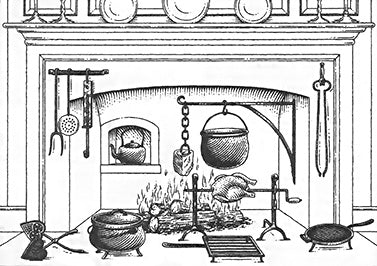Fireplace cranes throughout history have been a staple piece in colonial homes, as well as homes in the UK throughout the 19th century. However, they were not once so.
American hearths have existed since the stone age and have undergone various stages of modernization since. Native American cookery sites were simple, their utensils were made from natural substances such as wood, clay, stone, bone, shell, and hide. The cooking site was typically outside and typically consisted of a shallow pit lined with stone, sometimes a small tripod of stones was used to support rounded clay pots or stone griddles. They also used deeper cooking pits in which food was buried for steaming. They also had the ability to smoke and roast using racks they built of wood. Indoor cooking was also done, this was a similar version in which smoke escaped through a hole in the roof.
The earliest European settlers in the New World brought a concept of the hearth cooking that was similar and had in common the use of cooking in pits. However, they had a metallurgical advantage that the natives did not. The Europeans used metal trivets with legs, as well as iron trivets to hang various pots from. The Seventeenth-century American colonists brought even more architectural innovation, they improved floor fires and roof smoke holes by building fireplaces with stone or brick hearths and chimneys that extended through the roof and out of doors. This design had many advantages. Among them was a safer cooking environment. This brought the innovation and design of fireplace cranes and iron cooking pots. Fireplace cranes were used as a daily tool, making cooking more efficient and safer. One could now hang a cooking pot over the fire, utilizing the swinging arm to adjust the temperature inside the pot. Not only was this a better method for cooking, but it was also safer when it came time to remove the pot from the fire, as the crane could be swung out to the hearth.
The settlers used iron pots imported from Europe, which had very intentional designs that drew even more benefits from modernized hearth cooking. Some pots had legs on the bottom used for straddling coals, larger kettles incorporated swinging handles that hung them from a fireplace crane with S-hooks. Many pots had rounded bottoms, this transmitted the heat evenly preventing the food from becoming scorched. Their long handles allowed the cook to avoid the heat of the central fire, as did a variety of long-handled forged hand utensils. These included, spoons, ladles, turners, large forks etc.
Across New England and the UK, you will still see fireplace cranes. Though now they are more for aesthetics, charm, and nostalgia for history buffs, many hobbyists use them for cooking. The “modern” wood burning, and coal stoves did lead to the removal of fireplace cranes in some homes. However, blacksmithing is still very much alive. Acquiring a reproduction crane is very possible and desirable when restoring antique homes, or just for adding charm to a fireplace.
Want to learn more? New England Museums like the Mystic Seaport and Sturbridge Village offer open hearth cooking and blacksmithing classes.
Below is a recipe for Indian Pudding done on the hearth
Resource: https://www.oldhouseonline.com/
Author: Regina Cole
INDIAN PUDDING Recipe
serves 6–8
3 cups milk
2/3 cup cornmeal
1/2 teaspoon salt
2/3 teaspoon ground ginger
1/2 teaspoon ground cinnamon 1/2 teaspoon ground nutmeg
1 tablespoon butter
1/3 cup molasses
1/6 cup maple syrup
1/6 cup sorghum syrup*
1 egg, lightly beaten
1 additional cup milk
- Heat brick oven to around 400°F (or conventional oven to 350°); grease a 2-quart casserole.
- Scald milk and slowly whisk in cornmeal.
Over very low heat, stir continually until thick.
Add remaining ingredients except for the last cup of milk. - Pour into casserole and place uncovered in oven.
- After 45 minutes, pour 1 cup milk on top and bake for 3 hours in brick oven, 1 1/2 to 2 hours in conventional oven, until top is brown and crusty and liquid thoroughly absorbed.
- To serve, pour heavy cream over the pudding (it’s traditional), or use vanilla ice cream.
* Paula found some historic recipes calling for sorghum, with a taste similar to molasses but lighter. She also added maple syrup, assuming that a thrifty New England household would have it on hand, the Colonists having learned to tap trees from the Indians.
Below: Traditional Colonial Cooking Hearth

Photo Credits: Country Carpenters, and Mother Earth News
ILLUSTRATION: LIZ WHEATON
Featured Image: Milen Kovachev

